A Yeshua’s Cat Glossary
A recent reviewer commented that there were many terms and concepts in Yeshua’s Cat that were unfamiliar to a non-Christian, or even to a casual churchgoer. I apologize to my readers! I hadn’t really sat down and thought about it. I tried to avoid “God-talk” and gob-stoppers, but it’s always hard for someone who’s spent much of her life in university libraries to realize where common knowledge and academia part ways.
So here’s the first installment, A-D, of a list of words and concepts that might be strange to some readers. If I missed one that you would like to see included, please let me know, and I’ll add it in.
The parentheses after each word indicate the first page in the printed book where the word/concept appears. A simple map of 1st-century Israel is included below.
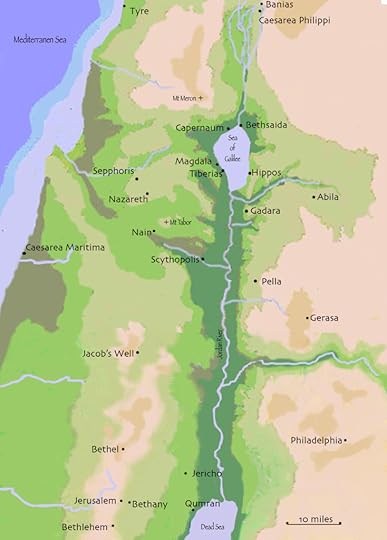
1st C. Israel, map C.L.Francisco
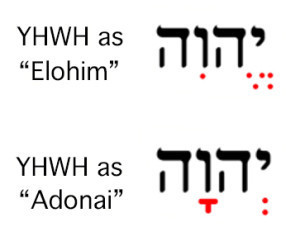
Hebrew name of God
* Adonai Elohim (p. 8) Whole books have been written on this phrase alone! It’s Hebrew, literally translated as “Lord God.” Adonai is generally translated as “lord,” or “master,” although it has ancient roots meaning “father” as well. Elohim is the plural form of the Hebrew word el, meaning “god.” I’m not going to get into the arguments about why it’s plural; it’s a very ancient form. In Jewish tradition, either the word Adonai or Elohim was spoken aloud whenever the scripture text included the name of God, YHWH. If you know anything about Hebrew, you’ll know that originally the written form had no vowels, only consonants. Later, vowels were added to the text as tiny dots and lines. When these later texts included the name YHWH, they inserted the vowel points used in the words Adonai or Elohim to remind readers never to speak the actual name of God aloud.
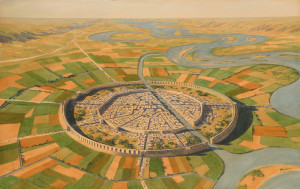
Artist’s Reconstruction of Mari, photo from Cielotech Online
* Amorite (p. 9) “People of the West,” or “people of (the god) Amurru,” a term originally referring to an ancient nomadic group found in Mesopotamia, Syria, and Palestine during the 3rd millennium BCE. Like most of the early peoples in the Ancient Near East, their origins are unclear; they may have come originally from Syria. They settled in Mesopotamia and assimilated its culture, eventually becoming the dominant ethnic group from about 2000 to 1600 BCE; they were probably responsible for the downfall of the ancient Sumerian civilization known as Ur III. They set up a number of Amorite kingdoms, among them the thriving city-state of Mari, and most importantly, Babylon. The great Babylonian king Hammurabi was an Amorite. By the time Joshua and the Israelites entered Canaan, the Amorites were living in the area around and north of the Dead Sea on both sides of the Jordan River, including the mountains of Judea and the area later known as the Decapolis. Their great cities had long since fallen into ruins. Some scholars believe that the patriarch Abraham’s roots were Amorite, but by the time of the Exodus, the two peoples no longer recognized any kinship: Joshua’s armies slaughtered great numbers of Amorites in the conquest of Canaan. By the time of the Greek and Roman empires, Jews had come to view the Amorites as a people contaminated by the worst excesses of superstition and pagan witchcraft.
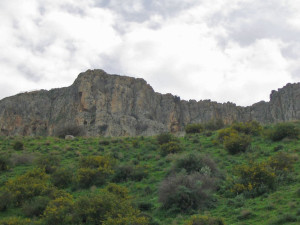
Arbel Cliffs
* Arbel cliffs (p. 23) The Arbel cliffs rose approximately 1200 feet above the biblical town of Magdala, on the western side of the Sea of Galilee. A major north-south caravan route ran beneath them along the shores of the Sea of Galilee, and another major road ran west between the cliffs toward Sepphoris and Nazareth along the course of the Arbel Stream. The cliffs were riddled with caves, used at various times by smugglers and bandits, and also by Jewish refugees and rebels. They were best-known in Jesus’ time for Herod the Great’s campaign against the Jewish rebels hiding in the caves in 40 BCE, when soldiers were lowered down the cliff face in baskets to kill the rebels and their families. The Arbel caves were used again during the 1st C CE Jewish uprising against the Romans that resulted in the burning of Jerusalem.
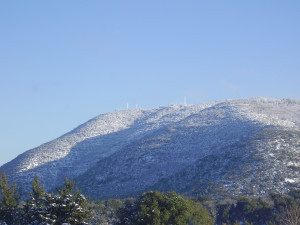
Mt. Meron, photo netanel h.
* barren expanse of rock (p. 200) The chapter and scene to which these words apply are references to an event called the “Transfiguration.” This was an event in the Gospels when Peter, James, and John shared a mountaintop vision of Jesus in which he was filled with light, and accompanied by Moses and the prophet Elijah. Since no particular mountain is mentioned, people have many ideas about where it might have taken place. Mt. Tabor, Mt. Horeb, Mt. Hermon and Mt. Meron have all been suggested. I decided that Mt. Meron fitted into the story best, so that’s the area I described in the book. According to the Gospels, Jesus had just left Caesarea Philippi, or Banias, just before the Transfiguration, and Mt. Meron is the highest mountain on the general route back toward the Sea of Galilee. It rises approximately 4,000 feet above sea level, roughly ten miles northwest of the northern shore of the Sea of Galilee.
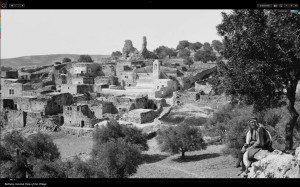
Bethany in the 19th century
* Bethany (p. 90) A small town to the east of Jerusalem where Jesus’ good friends Mary, Martha, and Lazarus lived. There is some disagreement about how the name “Bethany” should be translated. “House of figs” was one possibility, but I decided to go with the translation “house of the poor/poverty/affliction,” or “poor-house,” which is the translation most scholars choose. I identified Lazarus’ community as one of the Essene hospices, which were located in several areas in Israel.
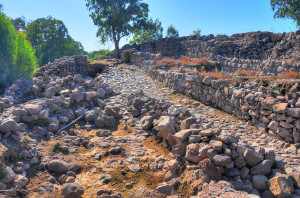
Cobbled street in Bethsaida, photo by biblewalks.com
* Bethsaida (p. 39) A small fishing village north of Capernaum on the very north end of the Sea of Galilee, on the east side of the Jordan River. Its exact location was long uncertain, since the most likely ruins lay some distance from the shore of the Sea of Galilee, perhaps because of changes in water levels over the centuries. Recent excavations have been able to identify the site more exactly. The Gospels say that the apostles Peter, Andrew, and Philip—and possibly James and John—came from this village.
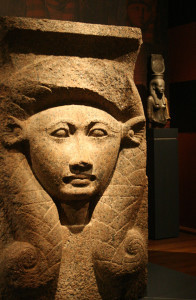
Hathor column capital from Bubastis, photo Nicholson CR
* Bubastian (p. 88) Relating to the Egyptian city of Bubastis, or Per Bast (“House of Bast”), where northern Egypt’s largest and most important temple to the goddess Bast was located. Bast, or Bastet, was a lion/cat goddess associated with fertility, joy, birth, death, and the rising sun. Over time she merged with the warrior goddess Sekhmet, and shared characteristics with Hathor and Isis. The Old Testament prophet Ezekiel mentions Bubastis (Ezek 30:17) when he prophesies the doom awaiting Egypt in the day of the Lord. He probably singled out Bubastis because of the licentious reputation of its annual festival.
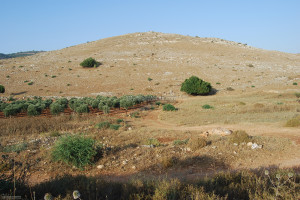
Possible site of biblical Cana, photo biblewalks.com
* Cana (p. 45) A small town in the hills of Galilee near Nazareth and Sepphoris. Its exact location is uncertain, although scholars have suggested several possible sites. Cana is best known for the wedding Jesus attended there, where he changed water into wine.
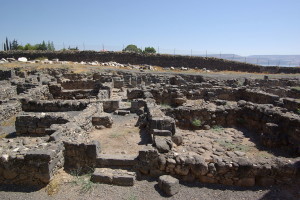
Ruins of Capernaum, photo Bertold Werner
* Capernaum (p. 25) Literally, “Village of Nahum,” a fishing village on the northwest shore of the Sea of Galilee, first occupied in the 2nd century BCE. The village was built largely of volcanic rock, which gave it a dark appearance. A small house traditionally believed to belong to the Apostle Simon Peter is located there. Jesus lived in Capernaum during his early Galilean ministry.
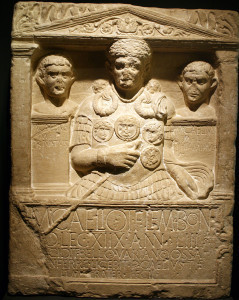
Monument to Centurion Marcus Caelius, 1st C CE
* centurion (p. 147) A Roman officer commanding a group of 100 men, which in Latin was called a century. Unlike the higher officers, centurions were usually regular enlisted men who had served for approximately 20 years and risen through the ranks.
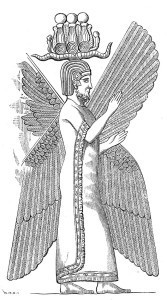
Relief of Cyrus the Great
* chosen (p. 9) In contemporary English Bibles this word is generally used to translate the Hebrew word “anointed.” It has a variety of biblical applications, but it always means favored or singled out by God for a special task or role. It was used of Abraham, David, and Jesus, as well as for the pagan ruler Cyrus the Great who released the Jews from their Babylonian captivity, and many others. It was also used of the people of Israel as a group and the community of Christians. The sense in which 1st C Jews used it often referred to a promised leader (messiah) who would deliver Israel from her enemies.
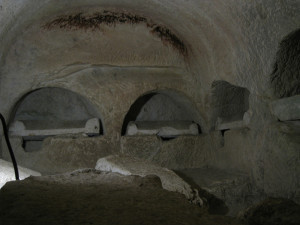
Temporary tombs at Beit Shearim
* charnel house (p. 123) Technically a charnel house is a building where the bones of the dead are stored after the flesh has been removed by any of a variety of means, including temporary burial. In a less specific sense it describes any place contaminated by the decomposition of human bodies. In ancient Israel burial was generally temporary: when the body had decayed in its stone tomb, the bones were transferred to a charnel pile, and the tomb reused. But for close to a hundred years, up until the destruction of Jerusalem in 70 CE, Jews around the Jerusalem area began burying bones in individual stone boxes called ossuraries.
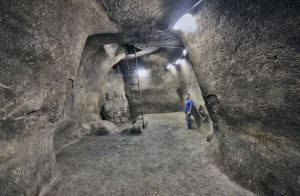
A very large Jerusalem cistern from the 10th C BCE
* cistern (p. 38) An underground water storage area, carved out of solid rock, and generally sealed with a layer of lime to prevent leakage. In countries like Israel, where rain fell mostly in the winter months, rain water was funneled along gutters into cisterns for summer use. Small cisterns were commonly dug for individual dwellings, and large ones for community use. Their small openings were usually covered with lids, and water was drawn from them as from wells.
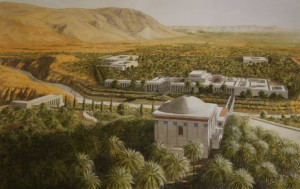
Herod’s Winter Palace Jericho, image by Archaeology Illustrated
* city near Mari’s home (p. 205) Yeshua found Mari on the western side of the Jordan (Descender) when he was on his way from his baptism by John to the desert where he spent 40 days fasting and praying. Thus the city near her home would have been Jericho.
* cohort (p. 147) A unit of ancient Roman armies made up of six centuries, or 600 men. The centurion whose servant Jesus healed would have commanded one of the centuries assigned to the local cohort.

A coney, or rock hyrax
* conies (p. 117) One of the English words used to translate the ancient Hebrew word which literally means “the hider.” The animal to which this word referred is probably the rock hyrax, a small furry beast living in dry rocky areas and related to the elephant (!).
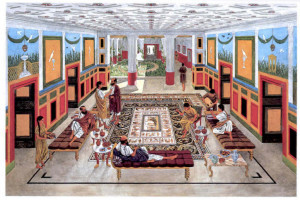
Artist’s reconstruction of a villa in rebuilt Sepphoris
* crucifixions at Sepphoris (p. 234) When Herod the Great died in 4 BCE, a number of rebellions broke out across Palestine, among them one led by Judas the Galilean, who captured Sepphoris, a Romanized town five miles from Nazareth. The Roman general Varus retaliated quickly, sacking the city and killing or enslaving as many as 30,000 local people suspected of participating in the uprising. The leaders were crucified, and their bodies left for carrion beasts. Josephus called the rebuilt city “the ornament of all Galilee.”
* Day of Atonement (p. 74) Day of Atonement is a translation of the Hebrew Yom Kippur, also known as the Sabbath of Sabbaths, the holiest day of the Jewish year, observed on the tenth day of the month of Tishrei. Yom Kippur is a day of strict fasting and rest. Starting at sunset on the day before, devout Jews spend the day in public and private prayer, confessing their sins against God, and begging for forgiveness. At the end of the day, they believe their sins to have been forgiven. The observance of Yom Kippur is mandated in one of the books of the Torah, Leviticus.
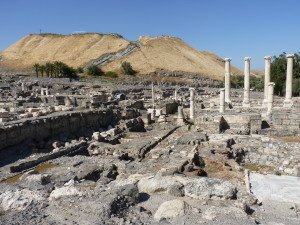
Scythopolis, photo Ricardo Tulio Gandelman
* Decapolis (p. 154) Decapolis meant literally “ten cities” in Greek, and referred to a loosely knit group of ancient cities in what is now Israel, Jordan, and Syria. No one can say for sure which cities were included in the ten–or even if there were exactly ten–since their relationship was never formalized in Greek or Roman law. As best we know, they were independent cities, each established as a polis, or city-state, with its own local sphere of influence. They supported each other because of their common ties of culture, similar economic interests, and commitment to the Greek, and later, Roman, empires. With the construction of Roman roads they became even more closely interconnected: outposts of the Roman Empire on its furthest eastern edges, islands of Greco-Roman speech and culture, determinedly set apart from the Aramaean, Nabataean, and Jewish populations all around them. Eight cities included in most lists were Gerasa, Scythopolis (or Beit-Shean), Hippos, Gadara, Pella, Philadelphia, Capitolias, and Abila.
* defiled hands (p. 150) This phrase refers to ancient Jewish concepts of purity and cleanliness. Ritual purity concerned the complex process of appearing before God in a pure state—which means (grossly simplified) not being contaminated by anything remotely related to death or pagan religion. Washing hands before eating was one of the lesser applications of the laws meant to insure that people were worthy to stand before God.
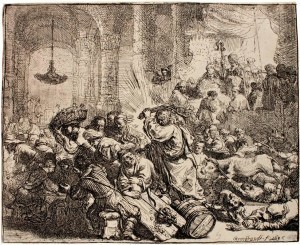
Rembrandt etching of Christ Driving the Money-Changers from the Temple
* den of thieves (p. 225) Mari eavesdropped here on Yeshua’s “cleansing of the temple,” which occurred when he entered the temple and found the outer courts filled with money changers’ tables and sellers of animals intended for sacrifice. (Foreign money could not be used for offerings in the temple because it generally had “graven images” on it: it had to be “changed” for Jewish coins.) Yeshua’s point was that such activities had no place in the courts of the temple itself. His words were drawn from the writings of the prophets Isaiah and Jeremiah.
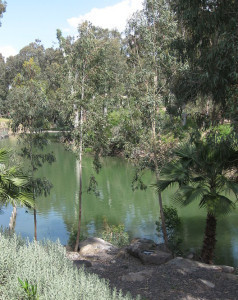
The Descender, photo Deror avi
* Descender (p. 14) This is the actual meaning of the Hebrew word yarden, which is usually transliterated as “Jordan” River. This is what speakers of Hebrew would have understood when the river’s name was spoken. People have speculated that the name derived from the great distance the river traveled in altitude in a short time, from its springs in the foothills of Mt. Hermon to the depths of the Dead Sea.
.
.
.





